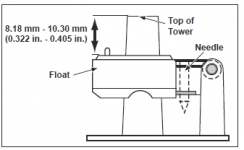OK, now that we understand each other.... (Brings back the thought of Churchill's famous quote..)
1. The float valve really can't restrain that much fuel "pressure". The modern float needles with the viton tip do better than the older metal and nylon versions, but still the "pressure limit" on fuel going into the carb has to be well below 1-2 psi. This is one reason for the fuel shut-off valve, whether manual or 'automatic', and/or the fuel pump. And by this last bit I mean that designers know that float valves are a weak point in the system, and so they purposely place the fuel tank BELOW the carb. In these designs, the fuel must be pumped up to the carb. Thus, when the pump (the engine) is turned OFF, excess fuel into the engine also stops.
When the fuel tank is placed above the carb, and sometimes this can't be done any other way [think motorcycle], fuel On/Off valves must be present. So the whole point of this is to say don't expect heroic efforts from your float needle. It's not within the realm of possibility. Therefore, high fuel levels in the carb must be the fault of something else. High fuel levels is then simply a symptom, not a direct cause.
2. So the photos of Westwood T1250's that I see, show a fuel tank above the level of the carb. You may have an automatic fuel shut off valve, but you'll need to add a manual in-line fuel shut off valve. This because 1) the automatic fuel valve cannot be trusted after a year in operation, and 2) you can't easily detect what effect that valve is having.
3. In addition, you cannot be sure that small grit has not entered the fuel system. So if you do not have an in-line fuel filter, then one needs to be installed. Installation of a filter simply adds a measure of insurance. Both the filter and manual fuel valve are inexpensive items.
4. Then, so that we can start "fresh" from the beginning, I would install a new carb float and float valve.
5. Lastly, and most importantly, I would begin a new operating procedure. One which will further insure your success. And here I assume you are some distance from your garage or storage shed where you park your mower. When you finish mowing, manually turn OFF the fuel. The engine will be able to run another 4-6 minutes without issue. During your drive back to the storage area, your float bowl will be emptied. This relieves the fuel pressure on the float system and insures the carb will NOT be flooded with fuel when you go to start the engine on the next day of use.
Implement these steps and your problems will be over, my friend.

